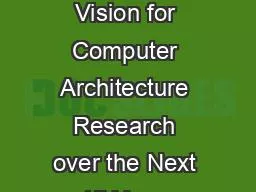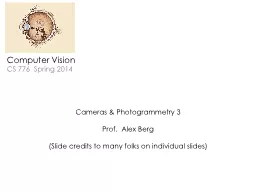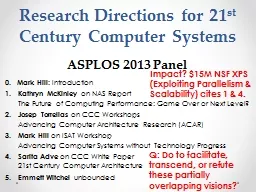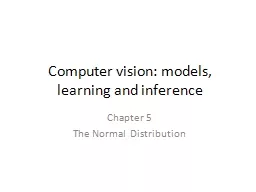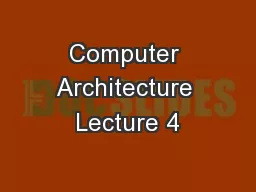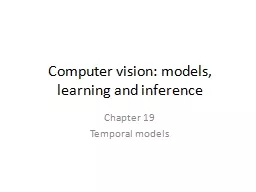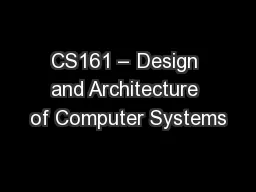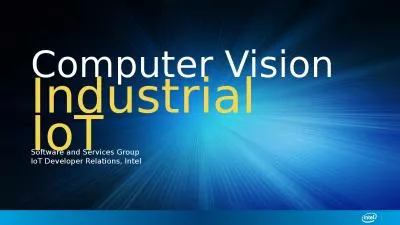PPT-Arch2030 : A Vision for Computer Architecture Research over the Next 15 Years
Author : solidbyte | Published Date : 2020-10-22
Luis Ceze Thomas Wenisch Mark Hill 40 members of the architecture community Arch2030 was supported by the CCC CRA 6 years ago What changed Why now Machine learning
Presentation Embed Code
Download Presentation
Download Presentation The PPT/PDF document "Arch2030 : A Vision for Computer Archit..." is the property of its rightful owner. Permission is granted to download and print the materials on this website for personal, non-commercial use only, and to display it on your personal computer provided you do not modify the materials and that you retain all copyright notices contained in the materials. By downloading content from our website, you accept the terms of this agreement.
Arch2030 : A Vision for Computer Architecture Research over the Next 15 Years: Transcript
Luis Ceze Thomas Wenisch Mark Hill 40 members of the architecture community Arch2030 was supported by the CCC CRA 6 years ago What changed Why now Machine learning is a key workload. 20 1027200 1048830 1054860 1081860 1126920 1137390 1180200 1192470 1229340 1282710 O7 826440 864840 882600 896730 922290 947580 976770 1005900 1035120 1126920 1204380 O6 612540 672960 717120 717120 719850 750720 754770 754770 797670 873510 918030 O5 CS 776 Spring 2014. Cameras & Photogrammetry . 3. Prof. Alex Berg. (Slide credits to many folks on individual slides). Cameras & Photogrammetry 3. http://. www.math.tu-dresden.de. /DMV2000/Impress/PIC003.jpg. st. Century Computer Systems. . ASPLOS . 2013 . Panel. 0. Mark Hill: . Introduction. Kathryn . McKinley. on NAS . Report. The . Future of Computing . Performance. : Game Over or . Next Level?. Josep. Chapter 5 . The Normal Distribution. Univariate. Normal Distribution. For short we write:. Univariate. normal distribution describes single continuous variable.. Takes 2 parameters . m. and . s. 2. Sequential Circuits. Ralph Grishman. September 2015. NYU. Time and Frequency. time = 1 / frequency. frequency = 1 / time. units of time. millisecond = 10. -3. second. microsecond = 10. -6. second. nanosecond = 10. Chapter 19 . Temporal models. 2. Goal. To track object state from frame to frame in a video. Difficulties:. Clutter (data association). One image may not be enough to fully define state. Relationship between frames may be complicated. H. orseshoe Arch. Origin unknown . Some say Umayyad, others say Visigoth (Spain), and still others say Byzantine or Sassanid. Compare to this Roman Arch. Pointed Arch. First used by Byzantines it will become the characteristic arch of Islamic Architecture. La gamme de thé MORPHEE vise toute générations recherchant le sommeil paisible tant désiré et non procuré par tout types de médicaments. Essentiellement composé de feuille de morphine, ce thé vous assurera d’un rétablissement digne d’un voyage sur . Introduction. Khaled N. Khasawneh, PhD Student. Department of Computer Science and Engineering. kkhas001@ucr.edu. Welcome!. 2. About me. Born and raised in . Jordan. Jordan University of Science & Technology, Jordan. . SYFTET. Göteborgs universitet ska skapa en modern, lättanvänd och . effektiv webbmiljö med fokus på användarnas förväntningar.. 1. ETT UNIVERSITET – EN GEMENSAM WEBB. Innehåll som är intressant för de prioriterade målgrupperna samlas på ett ställe till exempel:. kindly visit us at www.examsdump.com. Prepare your certification exams with real time Certification Questions & Answers verified by experienced professionals! We make your certification journey easier as we provide you learning materials to help you to pass your exams from the first try. Professionally researched by Certified Trainers,our preparation materials contribute to industryshighest-99.6% pass rate among our customers. kindly visit us at www.examsdump.com. Prepare your certification exams with real time Certification Questions & Answers verified by experienced professionals! We make your certification journey easier as we provide you learning materials to help you to pass your exams from the first try. Professionally researched by Certified Trainers,our preparation materials contribute to industryshighest-99.6% pass rate among our customers. Software and Services Group. IoT Developer Relations, Intel. 2. 3. What. is the Intel® CV SDK?. 4. The Intel® Computer Vision SDK is a new software development package for development and optimization of computer vision and image processing pipelines for Intel System-on-Chips (. Dr. Sonalika’s Eye Clinic provide the best Low vision aids treatment in Pune, Hadapsar, Amanora, Magarpatta, Mundhwa, Kharadi Rd, Viman Nagar, Wagholi, and Wadgaon Sheri
Download Document
Here is the link to download the presentation.
"Arch2030 : A Vision for Computer Architecture Research over the Next 15 Years"The content belongs to its owner. You may download and print it for personal use, without modification, and keep all copyright notices. By downloading, you agree to these terms.
Related Documents

